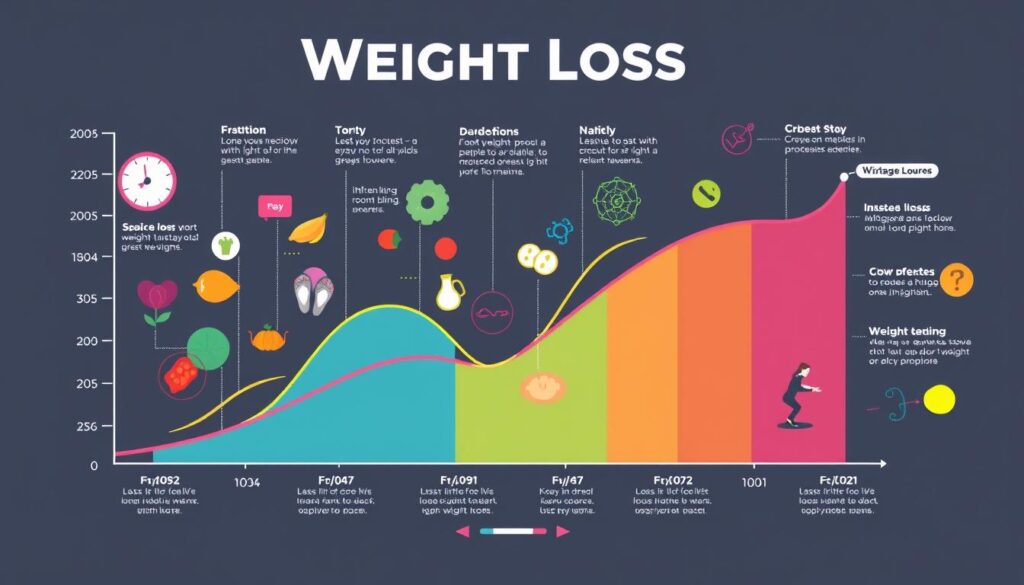If you’ve tried to lose weight, you might have seen the scale go up and down. This is because weight loss is not always straight. It’s more like a roller coaster, with quick weight loss followed by slower progress or even gaining weight.
Your body is very complex. It reacts differently to your weight loss efforts over time. The first weight loss might include gaining muscle and losing fat. Water weight changes are common, especially in the first few weeks. Women might also see weight changes due to their menstrual cycle.
As you keep going on your weight loss journey, losing weight gets harder. You need to work harder for less weight loss. The last 5-10 lbs are especially tough to lose. Weight loss charts from real people show that progress is not always steady or easy to predict.
Key Takeaways
- Weight loss is a non-linear process, often appearing more logarithmic or exponential.
- Body weight changes can vary significantly, with instances of losing weight, gaining weight, and even plateauing within short time frames.
- Initial weight loss may include building muscle and losing fat, with fluctuations due to water weight being common.
- Women may experience weight fluctuations related to their menstrual cycle.
- Weight can be influenced by various factors, including exercise, sleep patterns, time of day, and recent nutrition choices.
Understanding the Science Behind Non-Linear Weight Loss
Weight loss isn’t always easy. It’s not always a straight line. You might hit plateaus, see ups and downs, or even gain weight for a bit. Let’s explore why this happens with non-linear weight loss.
How Body Composition Affects Weight Changes
Your body composition is key in weight loss. If you have a lot of fat, you might lose weight but not see it. With less fat, you might not lose as much on the scale, but you’ll see changes.
The Role of Water Weight in Scale Fluctuations
Water weight affects your scale. Hormones, salt, and how much water you drink can change your weight. This can make it hard to see your real progress.
Impact of Hormones and Metabolism
Your hormones and metabolism matter too. Sleep, time of day, and what you eat can change your weight. Women, especially, should watch their weight during their period.
Knowing about non-linear weight loss helps you stay positive. It’s okay to have ups and downs. Focus on the big picture and celebrate your journey.
| Statistic | Value |
|---|---|
| Only 15% of dieters are able to maintain weight loss in the long term. | 15% |
| Studies show that 85% of dieters tend to regain the weight they lost within a year. | 85% |
| About 0.7% of body weight in pounds per week is considered a “healthy” target for weekly weight loss to maximize fat loss while minimizing metabolic adaptations and muscle loss. | 0.7% |
“Weight loss plateaus may lead to a period where hormone levels and metabolic rates are readjusted, impacting hunger levels, fatigue, and the potential for rapid weight gain if not managed correctly.”
Is Weight Loss Linear? Debunking Common Misconceptions
Many think weight loss is always steady. But, it’s not always true. Many things can change your weight, like water, muscle, and hormones.
One big myth is that the scale should always go down. But, your weight can change a lot in a day. It’s better to look at how you’re doing over time, not just daily.
- Myth 1: Extreme Diets Guarantee Quick Weight Loss
- Extreme diets can cause big health problems. They might even make losing weight harder.
- It’s better to eat well and make small, lasting changes.
- Myth 2: Certain Foods Can Burn Fat
- No food can make fat just melt away. Eating well and staying healthy is key.
- Things like your genes and how you live affect your weight loss more.
- Myth 3: Skipping Meals Leads to Weight Loss
- Skipping meals can hurt your metabolism and make you eat too much. It’s not good for losing weight.
- Eating well means having regular, balanced meals and paying attention to what you eat.
Knowing that weight loss isn’t always easy can help you keep going. Celebrate small wins, like feeling better and stronger.

Setting realistic goals and looking at your whole journey is important. By understanding the ups and downs, you can reach your health and fitness dreams.
The Reality of Weight Loss Progress Patterns
When you’re trying to lose weight, it’s not always easy. Your weight loss journey might look like a curve, not a straight line. You might lose weight fast, then slow down, or even gain a little. This is all normal and expected.
What a Typical Weight Loss Journey Looks Like
At first, you might lose weight quickly. This is because you’re losing water and changing your diet and exercise. But as you keep going, losing weight gets slower. This is because your body is getting used to the changes.
Understanding Weekly and Monthly Fluctuations
Your weight can change from day to day or week to week. This is okay. Things like water, hormones, and your diet can affect your weight. Look at the big picture, not just the daily numbers.
The Importance of Long-Term Trends
Success in weight loss is about the big picture, not just the scale. Look at how your clothes fit, how you feel, and your lifestyle changes. Keep going, and you’ll reach your weight loss goals.
| Statistic | Description |
|---|---|
| Weight-loss plateaus can last as long as eight to twelve weeks in the weight loss journey. | Plateaus are a normal part of the weight loss process, as the body adjusts to the new demands placed on it. |
| Scientists estimate that the average person will have a set-point range of 5-10% of their body weight, allowing for fluctuations in weight loss. | This means that your body has a natural range it tries to maintain, leading to variations in weight loss progress. |
| Two-thirds of people tend to regain all the weight lost and sometimes more after following a strict diet, emphasizing the importance of maintaining weight loss. | Sustainable weight loss requires lifestyle changes, not just temporary dieting. Focusing on long-term habits is key. |

Factors That Influence Weight Loss Variations
Weight loss is a complex journey. Many factors can affect your progress. Hormones, diet, exercise, and stress levels are key. Understanding these can help you on your weight loss path.
Your body’s hormones play a big role in weight loss. Hormones like thyroid and insulin affect how you lose weight. Carbs also matter, as they can change how much water you hold and affect your weight.
Exercise is important for losing weight. But the type and how hard you work out matters too. Hard workouts might make you hold more water at first. But regular exercise helps you lose fat and keep it off.
Stress is also a big factor. Too much stress can slow down your metabolism and make you eat more. Practices like meditation can help reduce stress. This can help you lose weight better.


A Life-Changing Experience with This Weight Loss Supplement (Nagano Tonic)
I’ve always struggled with finding a weight loss solution that actually works for me. Like many, I’ve tried numerous diets, exercise routines, and supplements over the years—some worked for a short time, but nothing ever gave me long-term results. That was until I decided to try the weight loss supplement I found : Link to the Supplement.
From the moment I started using it, I noticed a difference. Not only did I feel more energized, but my cravings also became more manageable. The best part? I started seeing results much quicker than I anticipated! Over the course of just a few weeks, I noticed a significant reduction in belly fat and overall weight loss that I hadn’t been able to achieve before.
What makes this supplement stand out from all the others I’ve tried is how it supports me in my daily routine without any jitters or energy crashes. I’m able to stay focused and motivated, which has made it easier to stay on track with my diet and exercise plan.
This product truly exceeded my expectations, and I feel more confident and healthier than ever before. If you’re struggling with your weight loss journey like I was, I highly recommend giving this supplement a try. It’s been a game-changer for me, and I’m sure it can work wonders for you too!
Contant Them on email .. tonicnagano50@gmail.com
I’ve tried so many weight loss products over the years, but nothing worked like this supplement! Since I started using it, I’ve noticed a big difference in my energy levels and appetite control. In just a few weeks, I’ve lost weight and feel so much better. It’s been easy to stick with, and the results speak for themselves. Highly recommend this to anyone looking to make a real change!
I was skeptical at first, but this supplement has truly made a difference in my weight loss journey. I’ve lost weight without feeling deprived or sluggish. My cravings are under control, and I feel more confident in my body. It’s easy to incorporate into my daily routine, and the results speak for themselves. I’m so glad I gave it a try!
Thanks David, i do use the link to make my purchase. you can get too here http://surl.li/iasppy
wasn’t sure what to expect, but this weight loss supplement has really impressed me! After just a few weeks of use, I’ve already dropped a few pounds and feel more motivated to stay active. It’s helped curb my cravings and boosted my energy throughout the day. I’m excited to keep going and see even better results. Definitely worth trying!
Reach them on tonicnagano50@gmail.com
I’ve tried so many weight loss products, but this one has been by far the most effective. In just a few weeks, I’ve noticed a visible difference in my body and energy levels. It’s helped me stay on track without the constant hunger pangs and cravings. I’m really happy with my progress and can’t wait to see where I’ll be in another month!
This Nagano Tonic has been amazing! In just a few weeks, I’ve lost weight, feel more energized, and my cravings are under control. Highly recommend it!
Thats the link to purchase http://surl.li/iasppy